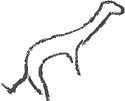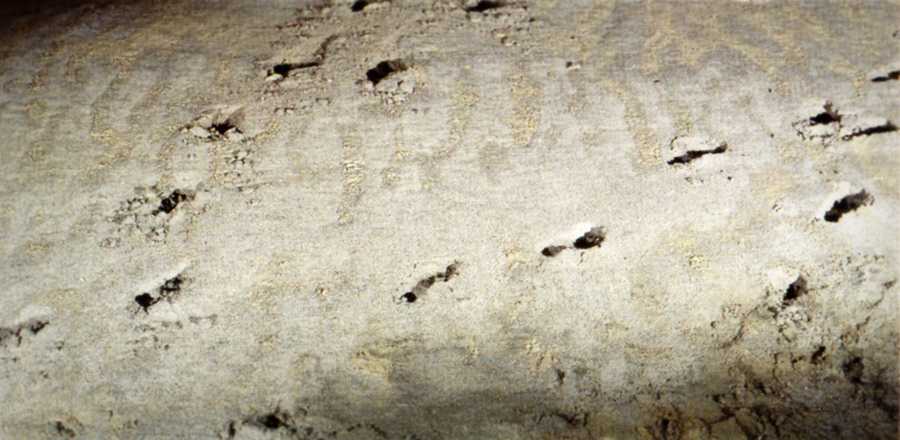


Bradshaw Foundation - Latest News
The Weasel of Niaux Cave
Friday 04 March 2016
The rock art research carried out by archaeologists over the last several decades has provided a clear inventory of the fauna depicted in the caves of Europe. Dr Jean Clottes describes Palaeolithic art, from beginning to end, as an art of animals; the most durable impression of the rock art is above all that of a bestiary, plentiful and various while remaining typical.
 Most of the animals represented are big herbivores, those that the people of the Upper Paleolithic could see around them and which they hunted. Those choices were not compulsory. They might have preferred to draw birds, fish or snakes, but they did not do so.
Horses are dominant. Locally they may be outnumbered by bison (the Ariege Pyrenees;) or hinds (Cantabrian Spain), occasionally even by rhinoceroses and lions at the very beginning (Chauvet) or, much later, by mammoths at Rouffignac (Plassard 1999). None the less, they always remain numerous whatever techniques were used at any period and in any region.
Most of the animals represented are big herbivores, those that the people of the Upper Paleolithic could see around them and which they hunted. Those choices were not compulsory. They might have preferred to draw birds, fish or snakes, but they did not do so.
Horses are dominant. Locally they may be outnumbered by bison (the Ariege Pyrenees;) or hinds (Cantabrian Spain), occasionally even by rhinoceroses and lions at the very beginning (Chauvet) or, much later, by mammoths at Rouffignac (Plassard 1999). None the less, they always remain numerous whatever techniques were used at any period and in any region.
 We might say that the theme of the horse is at the basis of Paleolithic rock art. This is all the more remarkable as that animal, even though present among the cooking debris of Paleolithic living sites, was often less plentifully killed and eaten than reindeer and bison, or again ibex in mountainous rocky areas. This means that it played a major role in the bestiary. The same could be said, even if less so, for the bison, whose images are also found in relatively high numbers from the Aurignacian to the end of the Magdalenian.
The importance of animal themes varies according to the different regions but much more in function of the periods considered. For example, the enormous number of normally rare dangerous animals in the Chauvet Cave created a surprise: rhinoceroses, lions, mammoths and bears represent 63% of the recognisable animal figures (Clottes (ed.) 2001).
However, this is not a unique phenomenon, isolated in time and space. In the Dordogne, at the same epoch, Aurignacians made use of the same themes in their shelters and their caves in much higher proportions than can be found in later art. This would mean that an important thematic change took place in the art of the south of France at the beginning of the Gravettian or at the end of the Aurignacian, when their choices changed from the most fearsome animals to the more hunted ones (Clottes 1996).
And then there are the exceptions. One such example is the weasel of Niaux.
The last major discovery in Niaux cave was made in 1970 when speleologists ventured into unexplored galleries, now known as Galerie Cartailhac. Here, more than 500 still visible foot imprints indicate that Prehistoric visitors walked over the floor in this cave. Pieces of charcoal and the remains of a torch prove that adults and children passed through, scraping their pine torches on the cave walls. They broke off several stalactites and stalagmites, leaving the pieces along the way. Five animal silhouettes have been painted; three bisons, a horse, and the final figure, a softly curving depiction of a weasel. It is the weasel that is, to date, a unique piece of artwork for the Palaeolithic period.
We might say that the theme of the horse is at the basis of Paleolithic rock art. This is all the more remarkable as that animal, even though present among the cooking debris of Paleolithic living sites, was often less plentifully killed and eaten than reindeer and bison, or again ibex in mountainous rocky areas. This means that it played a major role in the bestiary. The same could be said, even if less so, for the bison, whose images are also found in relatively high numbers from the Aurignacian to the end of the Magdalenian.
The importance of animal themes varies according to the different regions but much more in function of the periods considered. For example, the enormous number of normally rare dangerous animals in the Chauvet Cave created a surprise: rhinoceroses, lions, mammoths and bears represent 63% of the recognisable animal figures (Clottes (ed.) 2001).
However, this is not a unique phenomenon, isolated in time and space. In the Dordogne, at the same epoch, Aurignacians made use of the same themes in their shelters and their caves in much higher proportions than can be found in later art. This would mean that an important thematic change took place in the art of the south of France at the beginning of the Gravettian or at the end of the Aurignacian, when their choices changed from the most fearsome animals to the more hunted ones (Clottes 1996).
And then there are the exceptions. One such example is the weasel of Niaux.
The last major discovery in Niaux cave was made in 1970 when speleologists ventured into unexplored galleries, now known as Galerie Cartailhac. Here, more than 500 still visible foot imprints indicate that Prehistoric visitors walked over the floor in this cave. Pieces of charcoal and the remains of a torch prove that adults and children passed through, scraping their pine torches on the cave walls. They broke off several stalactites and stalagmites, leaving the pieces along the way. Five animal silhouettes have been painted; three bisons, a horse, and the final figure, a softly curving depiction of a weasel. It is the weasel that is, to date, a unique piece of artwork for the Palaeolithic period.
 By studying the weasel, Jean Clottes was able to determine that it had been created in 10 bold and faultless strokes; it was clearly the work of an experienced artist.
Why a weasel? This creature, a carnivorous mammal of the genus Mustela of the family Mustelidae, would have been noted possibly for its beauty and stealth, and perhaps admired for its fur. Given that, it is strange that this is the only known depiction of such a creature during the Palaeolithic.
For more information on the Niaux Cave visit the Bradshaw Foundation France Cave Paintings & Rock Art Archive Bradshaw Foundation - France Cave Paintings & Rock Art Archive
Comment
By studying the weasel, Jean Clottes was able to determine that it had been created in 10 bold and faultless strokes; it was clearly the work of an experienced artist.
Why a weasel? This creature, a carnivorous mammal of the genus Mustela of the family Mustelidae, would have been noted possibly for its beauty and stealth, and perhaps admired for its fur. Given that, it is strange that this is the only known depiction of such a creature during the Palaeolithic.
For more information on the Niaux Cave visit the Bradshaw Foundation France Cave Paintings & Rock Art Archive Bradshaw Foundation - France Cave Paintings & Rock Art Archive
Comment


Footprints on a sand dune in the Niaux cave
Article continues below
The Weasel of Niaux #Palaeolithic cave art paintings #France https://t.co/7hMZN3j8A1 #archaeology #Prehistoric #Art pic.twitter.com/MqwmiK17ZG
— Bradshaw Foundation (@BradshawFND) March 4, 2016

Cave Painting
→ Capturing the art of Cosquer
by Bradshaw Foundation
Monday 30 May 2022
→ Hand Stencils in Chhattisgarh
by Bradshaw Foundation
Wednesday 19 January 2022
→ New U-series dating of rock art in China
by Bradshaw Foundation
Thursday 06 January 2022
→ New approach to research in Australia
by Bradshaw Foundation
Monday 06 December 2021
→ Color begets life
by Bradshaw Foundation
Monday 29 November 2021
→ Sulawesi rock art
by Bradshaw Foundation
Monday 25 October 2021
→ Protecting Utyetye rock art
by Bradshaw Foundation
Monday 12 July 2021
→ A lockdown obsession with cave paintings
by Bradshaw Foundation
Monday 24 May 2021
→ What Sulawesi cave art reveals
by Bradshaw Foundation
Tuesday 20 April 2021
→ Cosquer cave replica underway
by Bradshaw Foundation
Thursday 01 April 2021
→ Oldest date for Aboriginal rock art
by Bradshaw Foundation
Tuesday 23 February 2021
→ Oldest cave painting found in Indonesia
by Bradshaw Foundation
Thursday 14 January 2021
→ Chauvet discovered 26 years ago today
by Bradshaw Foundation
Friday 18 December 2020
→ Response to 'discovery' claims in Colombia
by Bradshaw Foundation
Sunday 06 December 2020
→ Drug use and human creativity
by Bradshaw Foundation
Thursday 26 November 2020
→ Cave art discovered in Thailand
by Bradshaw Foundation
Wednesday 07 October 2020
by Bradshaw Foundation
Monday 30 May 2022
by Bradshaw Foundation
Wednesday 19 January 2022
by Bradshaw Foundation
Thursday 06 January 2022
by Bradshaw Foundation
Monday 06 December 2021
by Bradshaw Foundation
Monday 29 November 2021
by Bradshaw Foundation
Monday 25 October 2021
by Bradshaw Foundation
Monday 12 July 2021
by Bradshaw Foundation
Monday 24 May 2021
by Bradshaw Foundation
Tuesday 20 April 2021
by Bradshaw Foundation
Thursday 01 April 2021
by Bradshaw Foundation
Tuesday 23 February 2021
by Bradshaw Foundation
Thursday 14 January 2021
by Bradshaw Foundation
Friday 18 December 2020
by Bradshaw Foundation
Sunday 06 December 2020
by Bradshaw Foundation
Thursday 26 November 2020
by Bradshaw Foundation
Wednesday 07 October 2020
◼ ROCK ART NETWORK
◼ CAVE PAINTINGS
→ Capturing the art of Cosquer
by Bradshaw Foundation
Monday 30 May 2022
→ Hand Stencils in Chhattisgarh
by Bradshaw Foundation
Wednesday 19 January 2022
→ New U-series dating of rock art in China
by Bradshaw Foundation
Thursday 06 January 2022
→ New approach to research in Australia
by Bradshaw Foundation
Monday 06 December 2021
→ Color begets life
by Bradshaw Foundation
Monday 29 November 2021
→ Sulawesi rock art
by Bradshaw Foundation
Monday 25 October 2021
→ Protecting Utyetye rock art
by Bradshaw Foundation
Monday 12 July 2021
→ A lockdown obsession with cave paintings
by Bradshaw Foundation
Monday 24 May 2021
→ What Sulawesi cave art reveals
by Bradshaw Foundation
Tuesday 20 April 2021
→ Cosquer cave replica underway
by Bradshaw Foundation
Thursday 01 April 2021
→ Oldest date for Aboriginal rock art
by Bradshaw Foundation
Tuesday 23 February 2021
→ Oldest cave painting found in Indonesia
by Bradshaw Foundation
Thursday 14 January 2021
→ Chauvet discovered 26 years ago today
by Bradshaw Foundation
Friday 18 December 2020
→ Response to 'discovery' claims in Colombia
by Bradshaw Foundation
Sunday 06 December 2020
→ Drug use and human creativity
by Bradshaw Foundation
Thursday 26 November 2020
→ Cave art discovered in Thailand
by Bradshaw Foundation
Wednesday 07 October 2020
by Bradshaw Foundation
Monday 30 May 2022
by Bradshaw Foundation
Wednesday 19 January 2022
by Bradshaw Foundation
Thursday 06 January 2022
by Bradshaw Foundation
Monday 06 December 2021
by Bradshaw Foundation
Monday 29 November 2021
by Bradshaw Foundation
Monday 25 October 2021
by Bradshaw Foundation
Monday 12 July 2021
by Bradshaw Foundation
Monday 24 May 2021
by Bradshaw Foundation
Tuesday 20 April 2021
by Bradshaw Foundation
Thursday 01 April 2021
by Bradshaw Foundation
Tuesday 23 February 2021
by Bradshaw Foundation
Thursday 14 January 2021
by Bradshaw Foundation
Friday 18 December 2020
by Bradshaw Foundation
Sunday 06 December 2020
by Bradshaw Foundation
Thursday 26 November 2020
by Bradshaw Foundation
Wednesday 07 October 2020
Support our work & become a
Friend of the Foundation
Friend of the Foundation











